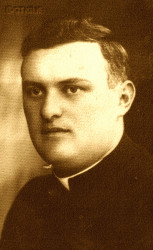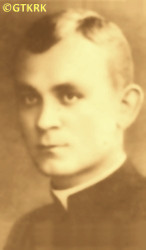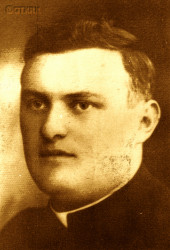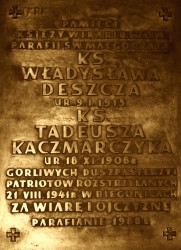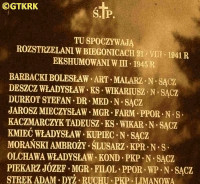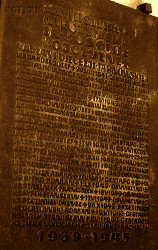Roman Catholic
St Sigismund parish
05-507 Słomczyn
85 Wiślana Str.
Konstancin deanery
Warsaw archdiocese, Poland
full list:
displayClick to display full list

searchClick to search full list by categories
wyświetlKliknij by wyświetlić pełną listę po polsku

szukajKliknij by przeszukać listę wg kategorii po polsku

Martyrology of the clergy — Poland
XX century (1914 – 1989)
personal data
religious status
Servant of God
surname
DESZCZ
forename(s)
Vladislav (pl. Władysław)
function
diocesan priest
creed
Latin (Roman Catholic) Church RCmore on
en.wikipedia.org
[access: 2014.09.21]
diocese / province
Tarnów diocesemore on
en.wikipedia.org
[access: 2013.05.19]
date and place
of death
21.08.1941

Biegonicetoday: neighborhood in Nowy Sącz, Nowy Sącz city pov., Lesser Poland voiv., Poland
more on
en.wikipedia.org
[access: 2021.04.01]
alt. dates and places
of death
22.08.1941
details of death
After German and Russian invasion of Poland in 09.1939 and start of the World War II, after start of German occupation, prob. collaborated with a growing clandestine resistance movement, part of a later Polish Clandestine State.
Arrested by the Germans on 02.07.1941 — together with another vicar in Nowy Sącz, Fr Thaddeus Kaczmarczyk, and the parish priest of the neighboring Trzetrzewina parish, Fr Joseph Bardel — for, among the others, the issuance of baptism certificates and help given to the Jews in the ghetto.
Already in the autumn of 1939, the Germans established separate local Jewish self‐governing authorities in Nowy Sącz, the so‐called Judenrat. Number of restrictions were introduced. Famine spread among the Jews. On 12.08.1940, the Germans created the so‐called „Jewish residential district”, consisting of two parts: for people working in the area known as Hell, and for those who did not work in the town centre. The latter was closed off in mid‐1941 with a 3‐meter–high brick wall. The Germans also established the Germ. Judische Ordnungsdienst (Eng. Jewish Security Service), with the help of which the resettlement of Jews to the ghetto continued until 08.1941. C. 12,000 Jews were then cordoned off.
And right then jailed, as a hostage, in Nowy Sącz prison.
On 21.08.1941 murdered in a mass execution of 44 prisoners, including Fr Joseph Bardel and Fr Thaddeus Kaczmarczyk.
The Germans liquidated the ghetto on 22‐28.08.1942, deporting c. 16,000 Jews to the VL Belzec extermination camp, where they were murdered.
cause of death
mass murder
perpetrators
Germans
sites and events
Biegonice (Nowy Sącz)Click to display the description, Nowy SączClick to display the description, Help to the JewsClick to display the description, GeneralgouvernementClick to display the description, Collective responsibility („Hostages”)Click to display the description, Ribbentrop‐MolotovClick to display the description, Pius XI's encyclicalsClick to display the description
date and place
of birth
09.01.1915

Pittsfieldtoday: Berkshire Cou., Massachusetts US‐MA state, United States of America
more on
en.wikipedia.org
[access: 2024.03.19]
parents
DESZCZ Stanislav
🞲 ?, ? — 🕆 ?, ?

KOWAL Marianne
🞲 ?, ? — 🕆 ?, ?
presbyter (holy orders)
ordination
29.06.1938

Tarnówtoday: Tarnów city pov., Lesser Poland voiv., Poland
more on
en.wikipedia.org
[access: 2021.06.07]
Nativity of the Blessed Virgin Mary RC cathedral churchmore on
en.wikipedia.org
[access: 2025.03.14]
positions held
1938 – 1941
vicar — Nowy Sącztoday: Nowy Sącz pov., Lesser Poland voiv., Poland
more on
en.wikipedia.org
[access: 2021.04.01] ⋄ St Margaret the Virgin and Martyr RC parish ⋄ Nowy Sącztoday: Nowy Sącz pov., Lesser Poland voiv., Poland
more on
en.wikipedia.org
[access: 2021.04.01] RC deanery
till 1938
student — Tarnówtoday: Tarnów city pov., Lesser Poland voiv., Poland
more on
en.wikipedia.org
[access: 2021.06.07] ⋄ philosophy and theology, Theological Seminary
others related
in death
BARDELClick to display biography Joseph, KACZMARCZYKClick to display biography Thaddeus
sites and events
descriptions
Biegonice (Nowy Sącz): Mass murder of 44 Poles — 32 of which were recognised during exhumation after the World War II (including 3 priests) — on Nowy Sącz prison inmates perpetrated by the Germans on 21.08.1941 in Biegonice village (today Nowy Sącz district), in retaliation for the release by the Polish resistance Home Army ZWZ of Mr John Karski, Polish resistance secret emissary, from Nowy Sącz hospital a year earlier. Most of the Poles were involved in resistance activities. (more on: pl.wikipedia.orgClick to attempt to display webpage
[access: 2014.09.21], www.karski-nowysacz.plClick to attempt to display webpage
[access: 2014.09.21])
Nowy Sącz: Penal prison run by the Germans. In 1939‐1945 it was also an execution site, mainly Poles arrested by the Germans. After end of warfare used by Commie‐Nazi UB, Polish branch of Russian KGB, to hold „forgotten soldiers” who continued to fight against Russian occupation after 1945. (more on: www.sw.gov.plClick to attempt to display webpage
[access: 2013.08.17])
Help to the Jews: During World War II on the Polish occupied territories Germans forbid to give any support to the Jews under penalty of death. Hundreds of Polish priests and religious helped the Jews despite this official sanction. Many of them were caught and murdered.
Generalgouvernement: After the Polish defeat in the 09.1939 campaign, which was the result of the Ribbentrop‐Molotov Pact and constituted the first stage of World War II, and the beginning of German occupation in part of Poland (in the other, eastern part of Poland, the Russian occupation began), the Germans divided the occupied Polish territory into five main regions. In two of them new German provinces were created, two other were incorporated into other provinces. However, the fifth part was treated separately, and in a political sense it was supposed to recreate the German idea from 1915 (during World War I, after the defeat of the Russians in the Battle of Gorlice in 05.1915) of creating a Polish enclave within Germany. Illegal in the sense of international law, i.e. Hague Convention, and public law, managed by the Germans according to separate laws — especially established for the Polish Germ. Untermenschen (Eng. subhumans) — till the Russian offensive in 1945 it constituted part of the Germ. Großdeutschland (Eng. Greater Germany). Till 31.07.1940 formally called Germ. Generalgouvernement für die besetzten polnischen Gebiete (Eng. General Government for the occupied Polish lands) — later simply Germ. Generalgouvernement (Eng. General Governorate), as in the years 1915‐1918. From 07.1941, i.e. after the German attack on 22.06.1941 against the erstwhile ally, the Russians, it also included the Galicia district, i.e. the Polish pre‐war south‐eastern voivodeships. A special criminal law was enacted and applied to Poles and Jews, allowing for the arbitrary administration of the death penalty regardless of the age of the „perpetrator”, and sanctioning the use of collective responsibility. After the end of the military conflict of the World War UU, the government of the Germ. Generalgouvernement was recognized as a criminal organization, and its leader, governor Hans Frank, guilty of war crimes and crimes against humanity and executed. (more on: en.wikipedia.orgClick to attempt to display webpage
[access: 2024.12.13])
Collective responsibility („Hostages”): A criminal practice implemented by the Germans in the occupied territories of Poland, applied from the very first day of World War II. At its core was an appointment and public announcement of a list of names of selected people whose lives depended on absolute compliance with German orders. Any violation of these ordinances, by any person, regardless of the circumstances, resulted in the murder of the designated „hostages”. In the first days of the war and occupation, it was used i.a. by the German Wehrmacht army to prevent acts of continuation of the defense by the Poles. Later, especially in the German‐run General Governorate, it was part of the official policy of the occupation authorities — collective responsibility for any acts of resistance to the occupier's practices. For the life of one German, even if death was due to customary reasons, the Germans carried out executions from a dozen to even a hundred Poles previously designated as „hostages”.
Ribbentrop‐Molotov: Genocidal Russian‐German alliance pact between Russian leader Joseph Stalin and German leader Adolf Hitler signed on 23.08.1939 in Moscow by respective foreign ministers, Mr. Vyacheslav Molotov for Russia and Joachim von Ribbentrop for Germany. The pact sanctioned and was the direct cause of joint Russian and German invasion of Poland and the outbreak of the World War II in 09.1939. In a political sense, the pact was an attempt to restore the status quo ante before 1914, with one exception, namely the „commercial” exchange of the so‐called „Kingdom of Poland”, which in 1914 was part of the Russian Empire, fore Eastern Galicia (today's western Ukraine), in 1914 belonging to the Austro‐Hungarian Empire. Galicia, including Lviv, was to be taken over by the Russians, the „Kingdom of Poland” — under the name of the General Governorate — Germany. The resultant „war was one of the greatest calamities and dramas of humanity in history, for two atheistic and anti‐Christian ideologies — national and international socialism — rejected God and His fifth Decalogue commandment: Thou shall not kill!” (Abp Stanislav Gądecki, 01.09.2019). The decisions taken — backed up by the betrayal of the formal allies of Poland, France and Germany, which on 12.09.1939, at a joint conference in Abbeville, decided not to provide aid to attacked Poland and not to take military action against Germany (a clear breach of treaty obligations with Poland) — were on 28.09.1939 slightly altered and made more precise when a treaty on „German‐Russian boundaries and friendship” was agreed by the same murderous signatories. One of its findings was establishment of spheres of influence in Central and Eastern Europe and in consequence IV partition of Poland. In one of its secret annexes agreed, that: „the Signatories will not tolerate on its respective territories any Polish propaganda that affects the territory of the other Side. On their respective territories they will suppress all such propaganda and inform each other of the measures taken to accomplish it”. The agreements resulted in a series of meeting between two genocidal organization representing both sides — German Gestapo and Russian NKVD when coordination of efforts to exterminate Polish intelligentsia and Polish leading classes (in Germany called «Intelligenzaktion», in Russia took the form of Katyń massacres) where discussed. Resulted in deaths of hundreds of thousands of Polish intelligentsia, including thousands of priests presented here, and tens of millions of ordinary people,. The results of this Russian‐German pact lasted till 1989 and are still in evidence even today. (more on: en.wikipedia.orgClick to attempt to display webpage
[access: 2015.09.30])
Pius XI's encyclicals: Facing the creation of two totalitarian systems in Europe, which seemed to compete with each other, though there were more similarities than contradictions between them, Pope Pius XI issued in 03.1937 (within 5 days) two encyclicals. In the „Mit brennender Sorge” (Eng. „With Burning Concern”) published on 14.03.1938, condemned the national socialism prevailing in Germany. The Pope wrote: „Whoever, following the old Germanic‐pre‐Christian beliefs, puts various impersonal fate in the place of a personal God, denies the wisdom of God and Providence […], whoever exalts earthly values: race or nation, or state, or state system, representatives of state power or other fundamental values of human society, […] and makes them the highest standard of all values, including religious ones, and idolizes them, this one […] is far from true faith in God and from a worldview corresponding to such faith”. On 19.03.1937, published „Divini Redemptoris” (Eng. „Divine Redeemer”), in which criticized Russian communism, dialectical materialism and the class struggle theory. The Pope wrote: „Communism deprives man of freedom, and therefore the spiritual basis of all life norms. It deprives the human person of all his dignity and any moral support with which he could resist the onslaught of blind passions […] This is the new gospel that Bolshevik and godless communism preaches as a message of salvation and redemption of humanity”… Pius XI demanded that the established human law be subjected to the natural law of God , recommended the implementation of the ideal of a Christian state and society, and called on Catholics to resist. Two years later, National Socialist Germany and Communist Russia came together and started World War II. (more on: www.vatican.vaClick to attempt to display webpage
[access: 2023.05.28], www.vatican.vaClick to attempt to display webpage
[access: 2023.05.28])
sources
personal:
www.greboszow.diecezja.tarnow.plClick to attempt to display webpage
[access: 2012.11.23], newsaints.faithweb.comClick to attempt to display webpage
[access: 2021.12.19]
bibliographical:
„Roman Catholic Church in Sącz country during II World War”, Fr John Kudelka, PhD dissertation, Zielona Góra 2014
original images:
pomnikprzejscie.plClick to attempt to display webpage
[access: 2025.02.11], bazylika.org.plClick to attempt to display webpage
[access: 2016.11.06], www.sadeczanin.infoClick to attempt to display webpage
[access: 2014.01.06], bazylika.org.plClick to attempt to display webpage
[access: 2016.11.06], www.sadeczanin.infoClick to attempt to display webpage
[access: 2014.01.06], strony.tarman.plClick to attempt to display webpage
[access: 2014.01.06]
LETTER to CUSTODIAN/ADMINISTRATOR
If you have an Email client on your communicator/computer — such as Mozilla Thunderbird, Windows Mail or Microsoft Outlook, described at WikipediaPatrz:
en.wikipedia.org, among others — try the link below, please:
LETTER to CUSTODIAN/ADMINISTRATORClick and try to call your own Email client
If however you do not run such a client or the above link is not active please send an email to the Custodian/Administrator using your account — in your customary email/correspondence engine — at the following address:

giving the following as the subject:
MARTYROLOGY: DESZCZ Vladislav
To return to the biography press below:
 Click to return to biography
Click to return to biography








